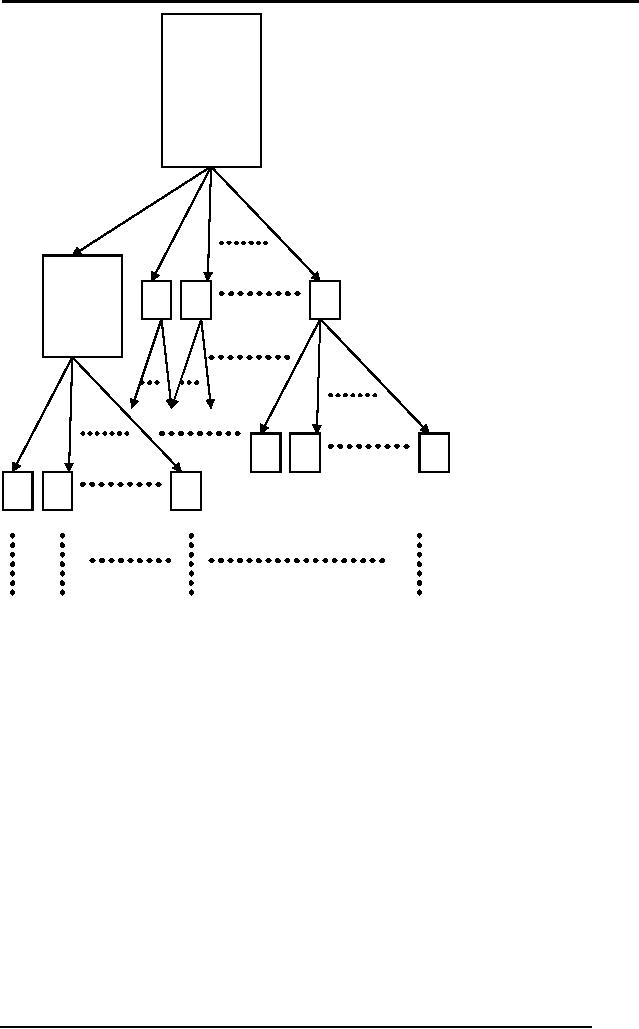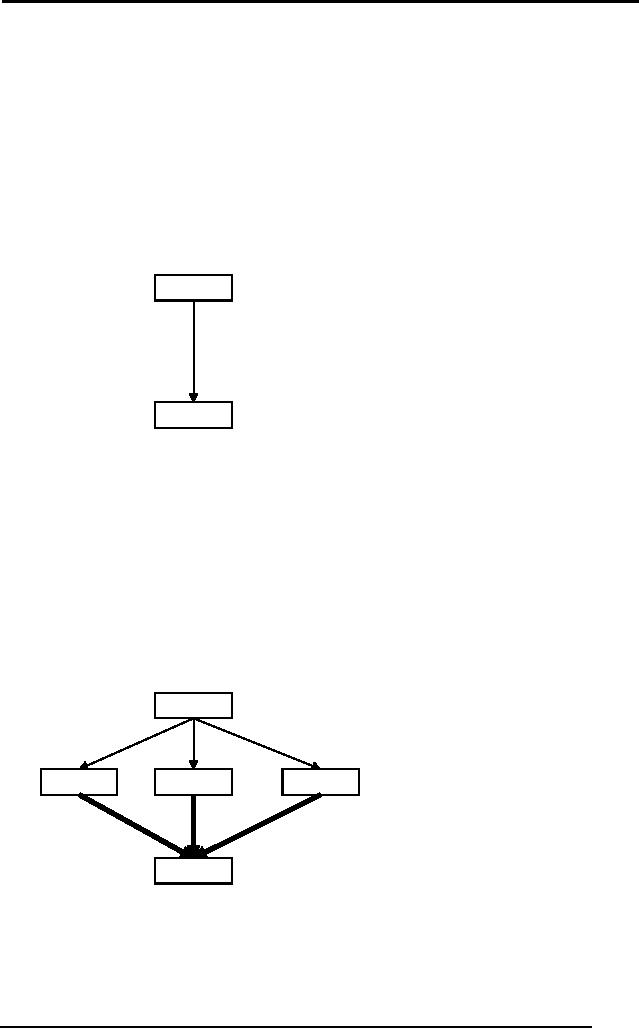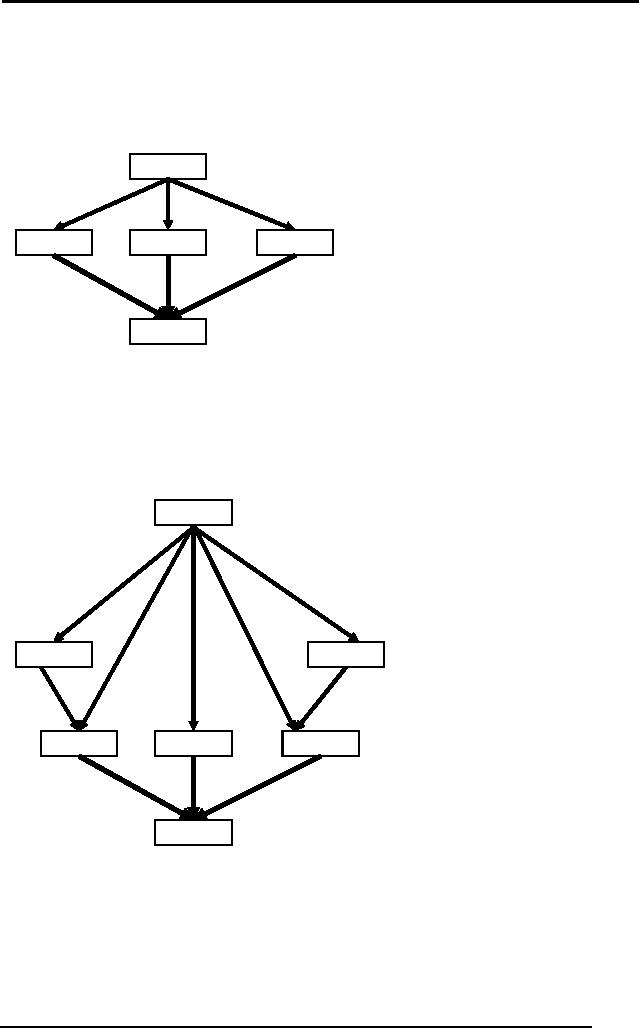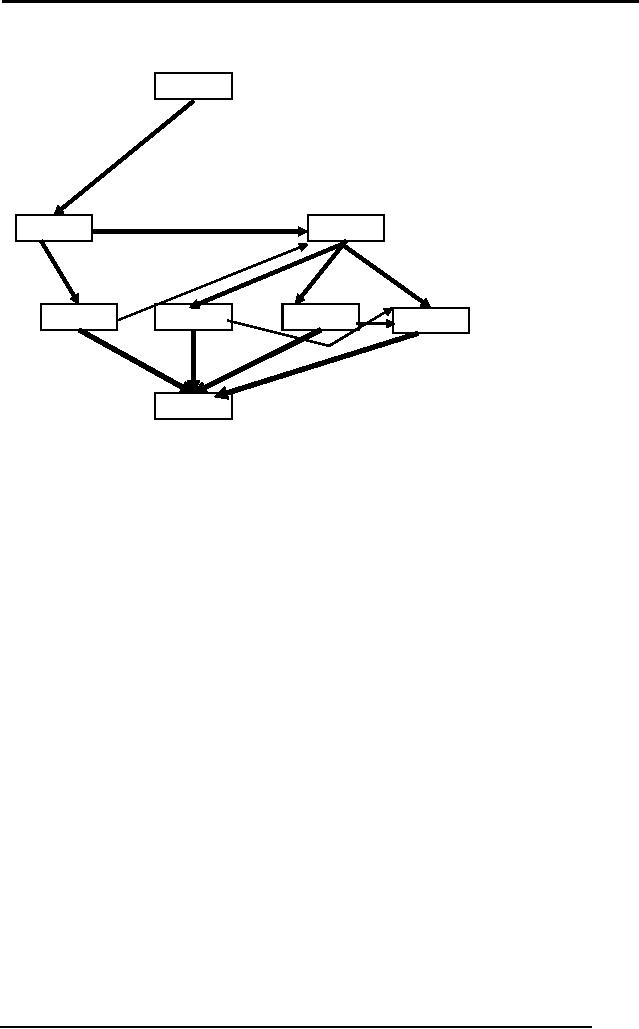 |
Planning |
| << Introduction to learning |
| Advanced Topics >> |

Artificial
Intelligence (CS607)
Location=Airpo
rt
Has
radio?=No
Sells
Figure
Search space
radio?=No
IsHotel?=No
of a moderate
problem
IsMarket?=No
ReservationDo
Although
this tree is
ne?=No
.
just a
depiction of
.
how a
search space
grows
for realistic
BuyRadio
problems,
yet after
TurnRightTurnLeft
seeing
this tree we
can
very
well
imagine
for even
Location=Airport
Has
radio?=No
Sells
radio?=No
more
complex
IsHotel?=No
X
X
X
IsMarket?=No
problems
that the
X
X
X
ReservationDone
?=No
X
X
X
.
search
tree could
.
.
be too
big, big
enough to
trouble
us. So
the question
is,
can we make
such
inefficient
problem
solving any
X
X
X
X
X
X
better?
X
X
X
X
X
X
X
X
X
Good news is
that
X
X
X
the
answer is yes.
How?
Simply
speaking,
this
`search'
technique
could be
improved
by acting a
bit logically instead of
blindly. For example not
using operators at a
state
where their usage is
illogical. Like operator
`sleeping' should not be
even
tried to
generate children nodes from
a state where I am not at
the hotel, or even
haven't
reserved the room.
The field of
acting logically to solve
problems is known as Planning.
Planning is
based on
logic representation that we
have already studied, so you
will not find it
too
difficult and thus we have
kept it short.
8.2
Definition of Planning
The key in
planning is to use logic in
order to solve problem
elegantly. People
working in AI
have devised different
techniques and algorithms
for planning. We
will
now introduce a basic
definition of planning.
Planning is an
advanced form problem
solving which generates a
sequence of
operators
that guarantee the goal.
Furthermore, such sequence of
operators or
actions
(commonly used in planning
literature) is called a
plan.
196

Artificial
Intelligence (CS607)
8.3
Planning vs. problem solving
Planning
introduces the following
improvements with respect to
classical problem
solving:
Each
state is represented in predicate
logic. De-facto representation of
a
�
state is
the conjunction (AND) of
predicates that are true in
that state.
The
goal is also represented as
states, i.e. conjunction of
predicates.
�
Each
action (or operator) is
associated with some logic
preconditions that
�
must be
true for that action to be
applied. Thus a planning
system can
avoid any
action that is just not
possible at a particular
state.
Each
action is associated with an
`effect' or post-conditions. These
post-
�
conditions
specify the added and/or
deleted predicates when the
action is
applied.
The
inference mechanism used is
that of backward chaining so as to
use
�
only
the actions and states that
are really required to reach
goal state.
Optional: The
sequence of actions (plan) is
minimally ordered. Only
those
�
actions
are ordered in a sequence
when any other order will
not achieve
the
desired goal. Therefore,
planning allows partial
ordering i.e. there
can
be two
actions that are not in any
order from each other
because any
particular
order used amongst them
will achieve the same
goal.
8.4
Planning language
STRIPS is
one of the founding
languages developed particularly
for planning. Let
us understand
planning to a better level by
seeing what a planning
language can
represent.
8.4.1 Condition
predicates
Condition
predicates are the
predicates that define
states. For example,
a
predicate
that specifies that we are
at location `X' is given
as.
at(X)
8.4.2
State
State is a
conjunction of predicates represented in
well-known form, for
example,
a state
where we are at the hotel
and do not have either cash
or radio is
represented
as,
at(hotel) ∧ �have(cash) ∧ �have(radio)
8.4.3
Goal
Goal is
also represented in the same
manner as a state. For
example, if the goal
of a planning
problem is to be at the hotel
with radio, it is represented
as,
197

Artificial
Intelligence (CS607)
at(hotel) ∧ have(radio)
8.4.4 Action
Predicates
Action is a
predicate used to change
states. It has three
components namely,
the
predicate
itself, the pre-condition,
and post-condition predicates.
For example,
the
action to buy something item
can be represented
as,
Action:
buy(X)
Pre-conditions:
at(Place) ∧ sells(Place,
X)
Post-conditions/Effect:
have(X)
What
this example action says is
that to buy any item `X',
you have to be (pre-
conditions) at a
place `Place' where `X' is
sold. And when you apply
this operator
i.e. buy
`X', then the consequence
would be that you have item
`X' (post-
conditions).
8.5
The partial-order planning algorithm
POP
Now that we
know what planning is and
how states and actions are
represented,
let us
see a basic planning
algorithm POP.
POP(initial_state, goal,
actions) returns plan
Begin
Initialize plan `p' with
initial_state linked to goal state with two
special actions, start and
finish
Loop until
there is not unsatisfied pre-condition
Find an action `a' which
satisfies an unachieved pre-condition of
some action `b'
in the plan
Insert `a' in plan linked
with `b'
Reorder actions to resolve
any threats
End
If you think
over this algorithm, it is
quite simple. You just start
with an empty plan
in which
naturally, no condition predicate of
goal state is met i.e.
pre-conditions of
finish
action are not met. You
backtrack by adding actions
that meet these
unsatisfied
pre-condition predicates. New unsatisfied
preconditions will be
generated
for each newly added
action. Then you try to
satisfy those by
using
appropriate
actions in the same way as
was done for goal
state initially. You
keep
on doing
that until there is no
unsatisfied precondition.
Now, at
some time there might be
two actions at the same
level of ordering of
them
one action's effect
conflicts with other
action's pre-condition. This is
called a
198

Artificial
Intelligence (CS607)
threat
and should be resolved.
Threats are resolved by
simply reordering
such
actions
such that you see no
threat.
Because
this algorithm does not
order actions unless
absolutely necessary it is
known as a
partial-order planning
algorithm.
Let us
understand it more by means of
the example we discussed in
the lecture
from
[??].
8.6
POP Example
The problem to
solve is of shopping a banana,
milk and drill from
the market and
coming
back to home. Before going
into the dry-run of POP
let us reproduce the
predicates.
The condition
predicates are:
At(x)
Has
(x)
Sells (s,
g)
Path (s,
d)
The initial
state and the goal state
for our algorithm are
formally specified as
under.
Initial
State:
At(Home)
∧
Sells
(HWS, Drill) ∧ Sells (SM,
Banana) ∧ Sells (SM,
Milk) ∧
Path (home, SM)
∧
path
(SM, HWS) ∧ Path (home,
HWS)
Goal
State:
At (Home)
∧
Has (Banana)
∧
Has (Milk)
∧
Has
(Drill)
The actions
for this problem are
only two i.e. buy and go. We
have added the
special
actions start and finish for
our POP algorithm to work.
The definitions for
these
four actions are.
Go (x)
Preconditions: at(y)
∧
path(y,x)
Postconditions: at(x)
∧
~at(y)
Buy
(x)
Preconditions: at(s)
∧
sells (s,
x)
Postconditions:
has(x)
Start ()
Preconditions:
nill
Postconditions:
At(Home) ∧ Sells (HWS,
Drill) ∧
Sells
(SM, Banana) ∧
Sells (SM,
Milk) ∧
Path (home,
SM) ∧ path (SM,
HWS) ∧ Path (home,
HWS)
Finish
()
Preconditions: At
(Home) ∧ Has (Banana)
∧
Has (Milk)
∧
Has
(Drill)
199

Artificial
Intelligence (CS607)
Postconditions:
nill
Note
the post-condition of the
start action is exactly our
initial state. That is
how
we have
made sure that our
end plan starts with
the initial state
configuration
given.
Similarly note that the
pre-conditions of finish action
are exactly the
same
as the
goal state. Thus we can
ensure that this plan
satisfies all the conditions
of
the
goal state. Also note
that naturally there is no
pre-condition to start and no
post-condition
for finish actions.
Now we start
the algorithm by just
putting the start and finish
actions in our plan
and linking
them. After this first
initial step the situation
becomes as follows.
Start
At(Home)
Sells(SM, Banana) Sells(SM,
Milk) Sells(HWS,
Drill)
Have(Drill)
Have(Milk)
Have(Banana)
At(Home)
Finish
Figure
Initial plan scene A
We now
enter the main loop of
POP algorithm where we
iteratively find any
unsatisfied
pre-condition in our existing
plan and then satisfying it
by an
appropriate
action.
At first
you see three unsatisfied
predicates Have(Drill), Have(Milk)
and
Have(Banana).
Lets take Have(Drill) first.
Have(Drill) matches the
post-condition
Have(X) of
action Buy(X), where X
becomes Drill in this case.
Similarly we can
satisfy
the other two condition
predicates and the resulting
plan has three new
actions
added as shown below.
Start
Figure
Plan scene B
At(s)
Sells(s, Drill)
At(s)
Sells(s, Milk)
At(s),
Sells(s, Bananas)
There is
no threat
Buy(Milk)
Buy(Bananas)
Buy(Drill)
visible in
the current
plan, so no
re-ordering
is
required.
Have(Drill),
Have(Milk), Have(Bananas)
At(Home)
At(Home)
Sells(SM, Banana) Sells(SM,
Milk) Sells(HWS,
Drill)
The
algorithm moves
Finish
forward. Now if
you see
the
Sells() pre-conditions of the
three new actions, they are
satisfied with the
post-conditions
Sells(HWS,Drill), Sells(SM,Banana), and
Sells(SM,Milk) of the
Start()
action with the exact
values as shown.
200

Artificial
Intelligence (CS607)
Start
At(HWS),
Sells(HWS, Drill)
At(SM),
Sells(SM, Milk)
At(SM),
Sells(SM, Bananas)
Buy(Milk)
Buy(Bananas)
Buy(Drill)
Have(Drill),
Have(Milk), Have(Bananas)
At(Home)
Finish
Figure
Plan scene C
We now
move forward and see
what other pre-conditions
are not satisfied.
At(HWS) is
not satisfied in action
Buy(Drill). Similarly At(SM) is
not satisfied in
actions
Buy(Milk) and Buy(Banana). Only
action Go() has
post-conditions that
can
satisfy these pre-conditions.
Adding them one-by-one to
satisfy all these
pre-
conditions
our plan becomes,
Start
Figure
Plan scene
D
Now if we
check
for
threats we
At(Home)
At(Home)
find
that if we go
to HWS
from
Go(HWS)
Go(SM)
Home we
cannot
go to SM
from
Home.
Meaning,
At(HWS),
Sells(HWS, Drill)
At(SM),
Sells(SM, Milk)
At(SM),
Sells(SM, Bananas)
post-condition
of
Buy(Milk)
Buy(Bananas)
Buy(Drill)
Go(HWS)
threats
the pre-
condition
Have(Drill),
Have(Milk), Have(Bananas)
At(Home)
At(Home)
of
Go(SM) and
vice
Finish
versa. So
as
given in
our POP algorithm, we have
to resolve the threat by
reordering these
actions
such that no action threat
pre-conditions of other
action.
That is how
POP proceeds by adding
actions to satisfy preconditions
and
reordering
actions to resolve any
threat in the plan. The
final plan using
this
algorithm
becomes.
201

Artificial
Intelligence (CS607)
Start
Figure
Plan scene
E
You can
see
how
reordering
At(Home)
At(Home)
is done
from this
illustration.
For
Go(HWS)
Go(SM)
example
the
threat
we
observed
At(HWS),
Sells(HWS, Drill)
At(SM),
Sells(SM, Milk)
At(SM),
Sells(SM, Bananas)
between
Buy(Milk)
Buy(Bananas)
Buy(Drill)
Go(Home)
Go(HWS)
and
Go(SM),
the link
from
Start to
Have(Drill),
Have(Milk), Have(Bananas)
At(Home)
Go(SM)
has
been
deleted
Finish
and a new
links
have
been established from
Go(HWS) and Buy(Drill) to
Go(SM).
To feel
more comfortable on the plan
we have achieved from this
problem, lets
narrate
our solution in plain
English.
"Start by
going to hardware store.
Then you can buy drill and
then go to the super
market. At
the super market, buy milk
and banana in any order and
then go
home. You
are done."
8.7
Problems
1. A Farmer
has a tiger, a goat and a
bundle of grass. He is standing at
one
side of
the river with a very
week boat which can
hold only one of his
belongings at a
time. His goal is has to
take all three of his
belongings to
the
other side. The constraint is
that the farmer cannot
leave either goat
and
tiger, or goat and grass, at any
side of the river unattended
because
one of
them will eat the
other. Using the simple
POP algorithm we
studied
in the
lecture, solve this problem.
Show all the intermediate
and final plans
step by
step.
2. A robot
has three slots available to
put the blocks A, B, C. The
blocks are
initially
placed at slot 1, one upon
the other (A placed on B
placed on C)
and
it's goal is to move all
three to slot 3 in the same
order. The constraint
to this
robot is that it can only
move one block from any slot
to any other
slot, and it
can only pick the
top most block from a
slot to move. Using
the
simple
POP algorithm we studied in
the lecture, solve this
problem. Show
all
the intermediate and final
plans step by step.
202